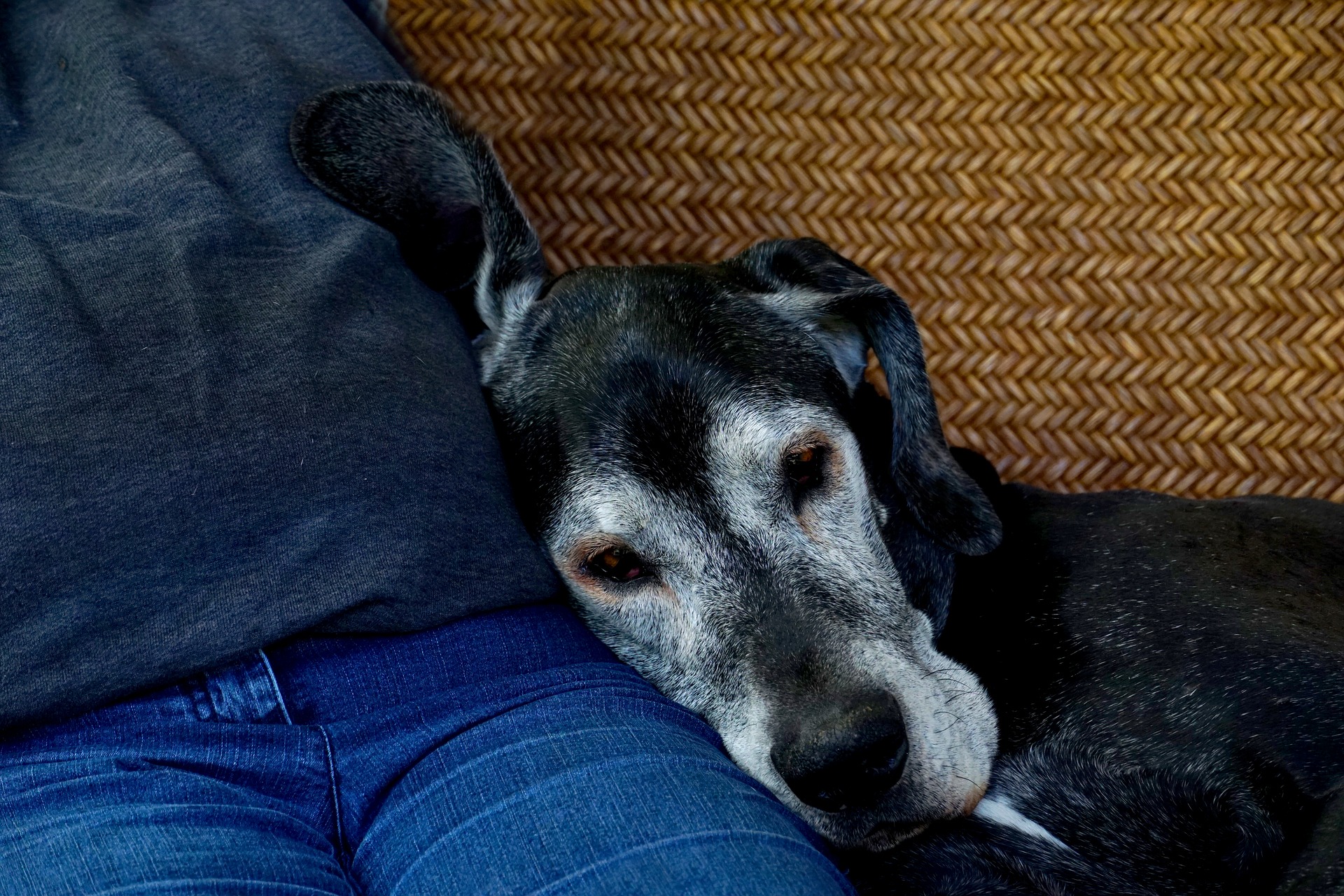Dr. Phil Zeltzman’s Blog
How do I know if my pet is in pain?
This is a very common question… and it does not have an easy answer.
An entire book could be written about pain!

Instead of a book, here are some general, practical guidelines.
1. Limping
This is one of the most difficult message to convey. Yet it’s simple.
LIMPING = PAIN – 99% of the time.
2. Decreased activity
If your pet suddenly or progressively doesn’t play as much or as long as usual, it’s important to find out why.
3. Difficulty in stairs
To simplify, going downstairs puts more pressure on the front legs, so they may be the issue.
And going upstairs puts more pressure on the back legs, so they may be the source of the problem.
4. Changing habits
If your dog runs like a maniac to greet you when you come back from work every single time, and progressively or suddenly doesn’t, why is that?
If your cat loves napping on a window sill to enjoy the sun, every single day after breakfast, and doesn’t anymore, why is that?
If your dog loves going on a walk, or a run, or a bike ride, and doesn’t anymore, why is that?
5. Difficulty jumping
If your pet routinely jumps on the couch, or your bed, on in your car, or on a chair, and suddenly or progressively doesn’t as easily, it may be because of pain.
6. Difficulty getting up
Struggling to get up after a nap or in the morning, or stiffness in the legs, can also be a sign of pain or arthritis.
7. Change in appetite
Painful pets often lose their appetite, even for a favorite treat. It could be sign of pain in a leg (difficulty walking to you or to the bowl), or neck pain (reaching the bowl, which may need to be elevated), or pain in the mouth or in the teeth.
8. Not wanting to be touched
Pain can lead to “guarding” a leg or the belly, or becoming “head shy”. A classic example is a pet with ear pain or an ear infection (e.g. Cockers). Similarly, no longer wanting to be petted or picked up is a sign to take seriously.
9. Hunched position
A hunched position can be a sign of belly pain or back pain. Either way it can be very serious.
10. Reluctance to move a body part
This can apply to legs, and also to the neck. If your dog doesn’t like moving the neck up, down or to the side, and tend to look at you without moving the head, it can be a sign of neck pain.
11. Hiding
Cats are notorious for this. Either they hide, or they sleep in unusual places.
12. Grooming changes
Not grooming as much, or over-grooming or licking a particular body part can also be a sign of pain or arthritis.
13. Vocalizing
Crying or vocalizing may be a sign of pain, but PLEASE do not count on that to decide your pet is in pain. Many pets, if not most, will not cry when in pain.
14. Aging
Just kidding!
As I always say, “age is not a disease.” While slowing down can be normal, just like in people, limping or being in pain is not.
We can successfully treat countless conditions we were unable to help with before. You no longer have to accept your pet no longer playing or not wanting to go on walks because he or she is “just getting old.” It’s probably because they are painful or have arthritis. Both can and should be treated!
15. Off
Nobody knows your pet as well as you do! Sometimes, a subtle change, a gut feeling, a new routine, can give you an indication that something’s off.
Trust your instinct. Don’t brush it off. Ask yourself – or you vet – what this is happening. Everything happens for a reason in the pet world!
Here are a few more important points to keep in mind:
1. Hiding
Animals are very good at hiding when something is wrong. Remember, in the Wild, if an animal acts sick, they get eaten. Sadly, our pets have kept this ability. Cats are notorious for that.
2. Expression
Pain and its expression can vary dramatically from breed to breed, and from pet to pet. We know for a fact that some pets are more stoic, and others are more… “sensitive”.
3. Surgery
In my world as a surgeon, surgery is a classic way to help painful patients. Fixing a broken leg, repairing a torn ACL or removing a cancerous mass are just a few examples.
4. No surgery
But keep in mind that there are many ways to decrease or stop the pain without surgery including: weight loss, cold therapy, heat therapy, joint supplements, environmental changes, improving traction, acupuncture, harnesses, physical therapy, massage etc.
5. Warning
Please do NOT give any medication over the counter, or any human medication, or leftover medication from this or another pet, unless directed by your veterinarian.
Many human drugs are toxic to our pets, even deadly.
Something as “simple” as aspirin is a huge problem in a pet because:
1. We cannot give a better, safer, stronger anti-inflammatory drug for 7 days after stopping the aspirin and
2. If surgery is necessary, we cannot perform it safely for 7 days because aspirin thins the blood and increases the risk of bleeding!

ANY source of pain should be a reason to see your family vet or a board-certified surgeon.
As I always say, “pain is not acceptable.”
Pain should be taken very seriously – and vets are here to help you, help your pet.
Phil Zeltzman, DVM, DACVS, CVJ, Fear Free Certified

Dr. Phil Zeltzman is a traveling veterinary surgeon in Pennsylvania & New Jersey. An award-winning author, he loves to share his adventures in practice along with information about vet medicine and surgery that can really help your pets. Dr. Zeltzman specializes in orthopedic, neurologic, cancer, and soft tissue surgeries for dogs, cats, and small exotics. By working with local family vets, he offers the best surgical care, safest anesthesia, and utmost pain management to all his patients. Sign up to get an email when he updates his blog, and follow him on Facebook, too!
What Is Quality of Life For a Pet?
I frequently have difficult conversations with pet owners that revolve around quality of life.
Most recent examples include:
. Is it ethical to perform ACL surgery in a pet with cancer?
. Is it reasonable to perform surgery in a 13 year old dog with laryngeal paralysis (ie who suffocates around the clock)?
. Is it fair to amputate a pet who has non-operable cancer on a leg?
It certainly depends on the situation, but overall the answer is YES – for the right pet and the right pet owner.

Pets don’t need a vacation home, stock options or designer clothes.
What they do need is being able to eat, drink, breathe, walk, urinate, defecate, groom and sleep – all in a pain free manner. And hopefully, you can expect a little tail wag here and there from a dog and a happy meow from a cat.
This list is certainly debatable, I admit it. One could add that a pet should be free of loneliness, fear and boredom. But I think the short list is a good starting point when you consider medical conditions.
If any of these basic bodily functions doesn’t take place, or if it occurs with difficulty, discomfort or pain, then your pet has a decreased quality of life.
What can you do then? You need to start by having a serious conversation with your family veterinarian. Or a board-certified surgeon.
Questions that need to be answered are:
. Is my pet suffering?
. Why is my pet painful?
. How can we decrease the pain?
. Can medications help?
. Can surgery help?
Of course, you may not hear the real story, the truthful story, because some people may not be bold or upfront enough to tell you what you need to hear.
I regularly talk to clients whose cat has been beyond constipated for YEARS before they got help (surgery is the only realistic solution).
I regularly talk to clients whose dog has been struggling to breathe for months or even years before they sought help (surgery is the only realistic solution).
I regularly talk to clients who had been told that a skin mass is not a big deal, or that a mass cannot be removed… when it truly is a big deal, and it absolutely can and should be removed.
Of course, surgery is not always the only option, I’m much more objective than that!
If your dog limps, pain medications, surgery, joint supplements, weight-loss or a “joint food” might help.
If your pet has a hormone imbalance, medications may solve the problem. The list goes on…
How can you tell if your pet’s quality of life is changing?
One subjective but simple way is to use a scale from 1 to 10, 1 being the poorest quality of life and 10 being the best. If you rate your pet as a 9 in January and a 2 in May, then it is time to face the evidence. It’s time to have a heart-to-heart discussion with your family and your veterinarian about what can realistically be done.
If you are starting to wonder about your pet’s quality of life, here is my suggestion: print a few copies of the “HHHHHMM” Quality of Life scale. Then fill in one table regularly – monthly, weekly or even daily depending on the situation.
This will help you see a trend more objectively: is your pet’s status the same, better, or worse than last time you assessed the situation?
Remember this very important concept: “age is not a disease.” Just because a pet is 12 or 14 or 16 years old does not mean you should give up easily. That said, if neither pain management nor medical and surgical treatments can help, then maybe it is time to consider euthanasia.
As emotionally and ethically difficult as it is for a pet owner, the whole family, and the veterinarian and his/her staff, euthanasia is sometimes the only reasonable, humane solution. It may be the only way your pet finds relief.
Quality of life includes your pet’s right to stop suffering with dignity once all reasonable options have been exhausted.
Phil Zeltzman, DVM, DACVS, CVJ, Fear Free Certified

Dr. Phil Zeltzman is a traveling veterinary surgeon in Pennsylvania & New Jersey. An award-winning author, he loves to share his adventures in practice along with information about vet medicine and surgery that can really help your pets. Dr. Zeltzman specializes in orthopedic, neurologic, cancer, and soft tissue surgeries for dogs, cats, and small exotics. By working with local family vets, he offers the best surgical care, safest anesthesia, and utmost pain management to all his patients. Sign up to get an email when he updates his blog, and follow him on Facebook, too!
Top 10 Reasons To Neuter Your Pet
Clearly today’s topic is sensitive and it will ruffle some feathers… but please hold the hate mail.

It never ceases to amaze me the number of cats and dogs who end up on my surgery table because they were not neutered. Many end up hit by a car. Many end up with a specific type of hernia (more below).
Then there are all the non-surgical reasons, starting with behavior problems.
Are you wondering whether you should neuter your cat or your dog? Here is a non-exhaustive list of 10 reasons to do it.
1. Unwanted pregnancies
Ah… Love at first sight… It’s really difficult for an intact male to resist a female in heat! An intact male classically runs away and can follow the smell of a pretty female in heat located miles away. And keep in mind that one single incident can lead to 4, 8 or 10 puppies or kittens!
Incidentally, you may be liable if your male procreates with somebody’s prized female. Suddenly, the miracle of life has a bittersweet taste, doesn’t it?
2. Pet overpopulation
Meanwhile, 3 to 4 million of unwanted pets are euthanized each year. What a tragedy… This is called “pet overpopulation”.
Many of these deaths could have been avoided by neutering males (and spaying females).
So sterilizing your pet ultimately makes the world a better place.
3. Behavior
Unneutered pets have all kinds of behavioral problems. In male dogs, the most common behavior is an aggressive temper. Of course, there are many intact pets who are perfectly sweet. Neutering, when done early in life, can reduce aggressiveness and improve behavior overall. For example, it decreases the always-awkward “mounting” behavior in dogs.
4. Marking
Few things smell worse than intact male cat urine. Some people make their indoor cat an outdoor cat when they can’t tolerate the smell anymore. This increases the risk of being hit by a car or getting into a fight. Neutering, when done early enough in life, virtually eliminates the odor of male cat urine and should prevent marking in male dogs.
5. Roaming and getting in trouble
Pets are rarely taught how to cross the street safely. So when they roam, searching for trouble or looking for a partner, they might get hit by a car.
In fact, many pets I treat for a fracture are intact. Neutering reduces the urge to roam or run away from home.
In addition, neutering decreases the risk of getting into a fight, especially in tom cats. They commonly get nasty abscesses from these fights.
Family and emergency vets regularly see wounds from dog bites, and I assure you that it’s rarely pretty. I’ve seen many dogs die after getting attacked by another dog.

6. Roaming and getting lost
Every year, millions of pets get lost. Some are returned to their owner. Most are not. To decrease the risk of such a tragedy happening in your family, neuter your pet, pet-proof the fence in your backyard and always keep your pet on a leash during walks.
In addition, talk to your vet about the benefits of tattoos and microchips.
7. Prostate disease
Intact male dogs can have a number of diseases of the prostate including cysts, abscesses and enlargement. The latter is called “benign prostatic hyperplasia,” just as in older men. Neutering (of dogs!) prevents these problems.
8. Perineal hernia
A perineal hernia is a fixable but annoying problem mostly seen in intact male dogs. Organs from the belly can slip or herniate through weakened muscles in the pelvis. The consequence is a bulge on one or both sides of the anus. The hernia can contain fat, fluid or even the bladder. These hernias frequently cause constipation.
This condition is believed to be due to testosterone (from the testicles). Neutering dramatically reduces the risk of these hernias.
9. Testicular tumors
Neutering eliminates the risk of testicular cancer. This condition, mostly seen in intact male dogs, is believed to be due to testosterone (from the testicles). It’s simple, really: no testicles, no testicular cancer.
One more reason to neuter is when a male is cryptorchid, i.e. when a testicle does not come down and remains in the belly. The testicle left in the belly has a much higher risk of becoming cancerous. So this may require 2 surgeries: 1 to remove the “outside” testicle, and 1 in the belly to find and remove the other one. Occasionally, both testicles are in the abdomen.
10. Genetics
Yet another reason to neuter is to prevent spreading bad genes. Pets with hip dysplasia, eye diseases, heart conditions and many other genetic conditions should not be allowed to breed.
It seems, however, that neutering does not decrease, and in fact may increase, the risk of prostate cancer. Luckily, this is a very rare tumor. Therefore, the combined benefits of neutering vastly outweigh the risk of prostate cancer as you can see from this top 10 list.
The next controversy is when to neuter your pet. Again, hold the hate mail: most reasonable vets recommend neutering at 6 months of age.
Phil Zeltzman, DVM, DACVS, CVJ, Fear Free Certified

Dr. Phil Zeltzman is a traveling veterinary surgeon in Pennsylvania & New Jersey. An award-winning author, he loves to share his adventures in practice along with information about vet medicine and surgery that can really help your pets. Dr. Zeltzman specializes in orthopedic, neurologic, cancer, and soft tissue surgeries for dogs, cats, and small exotics. By working with local family vets, he offers the best surgical care, safest anesthesia, and utmost pain management to all his patients. Sign up to get an email when he updates his blog, and follow him on Facebook, too!
How to Be Your Pet’s Best Advocate
As a pet owner, you are responsible for your pet’s wellbeing. You need to be your pet’s best health advocate.

I’m regularly surprised when I hear pet owners confess that they are “totally confused” or overwhelmed after a visit with a family vet or a vet specialist.
They may be confused because of their own stress level during the visit, because of their emotional state, or because the vet used hard-to-understand medical jargon.
As between friends, family members, and even countries, the root of most problems is miscommunication.
So maybe having a checklist would help you avoid misunderstanding your pet’s care and make better decisions.
Of course, every condition, every pet, every visit is different.
But let’s see if we can come up with guidelines that will work for most visits.
Let’s go over important points to remember before, during and after your visit at the vet.
Before the visit:
. Research: Before your visit, research the practice and the vet. Is it a general or a specialty hospital? Are you meeting with a generalist or a specialist? A generalist will have the letters DVM after their name. There is one exception: general vets who graduate from Pennsylvania have the letters VMD after their names.
A specialist will have the same letters (DVM or VMD), followed by more letters.
A board-certified surgeon (like me) will also mention something like DACVS or Dip. ACVS, which stands for Diplomate of the American College of Veterinary Surgeons.
A board-certified internist will also mention DACVIM or Dip. ACVIM, which stands for Diplomate of the American College of Veterinary Internal Medicine.
The list goes on, depending on the specialty.
If they don’t have those additional letters after their names, they cannot call themselves specialists. It does not mean they aren’t competent to treat your pet. It does mean that they are not considered specialists by our governing veterinary organizations and shouldn’t call themselves specialists.
Don’t always trust what you read online, however what have previous pet owners thought of their interactions? Pay a quick visit to the practice website, Facebook page and Google description. I would stay away from other more “questionable” sites, which I won’t mention here. One is notoriously unreliable. Enough said.

See what the common theme is: was the vet especially kind? A true pet lover? Genuinely caring? Easy to understand?
The tough part is what to do with negative comments. Are they real? Or are they posted by disgruntled clients who can never be satisfied, are chronic complainers, or who wrongly accuse the vet for being the worst simply because they can’t afford their treatment?
If you really want to be thorough, you can visit the website of the veterinary board for your State and make sure your vet’s license is in good standing, and that no complaint was filed against them. It’s public information. It’s a bit extreme, but not completely ridiculous.
. Goals: What are your goals going to the vet? Make a list of 2 or 3 important questions you have. Not 10 or 20 or 30. Limit yourself to 2 or 3.
. Quality of life: How is your pet’s quality of life now? Has it deteriorated? Are you trying to improve it?
. Symptoms: Bring a list of the problems or symptoms you’ve noticed with your pet, and when. Keep a log, either on paper, or in a physical calendar, or digitally. If there is a known cause, write it down.
For example: “July 10 – not using right back leg normally after playing ball. July 15 – limping about 33% of the time. July 20 – limping 75% of the time.”
. Medications: Prepare a list of all medications, vitamins and supplements. In addition, bring the actual drugs with you, just in case.
Include every medication you give, why you’re giving it, the prescribing doctor, and the dosage. You can provide a simple log like this:
. Drug name (generic or brand name).
. Prescribing doctor.
. Reason for giving it.
. How much you give (in tablets, capsules, mg or ml).
. How often you give it.
. Any reaction or side-effect noticed.
For example: “On April 25, Dr. Smith prescribed gabapentin for pain control. I give 300 mg every 8 hours. Chelsea is doing much better on it. No side-effects noticed.”
This information is very important to a vet. We need to know what works and what doesn’t. And we also need to make sure there are no interactions.
. Allergies: Bring a list of known allergies or bad reactions: fleas, grass, pollens, chicken, carprofen…
. Records: If you’re going to a new family vet, be sure to have a copy of previous medical records that include previous vaccines, conditions and treatments.
. CPR: If your pet might need anesthesia, you will be asked if you want your vet to do CPR or not in case of serious emergency. Rather than CPR, the form may ask if you want to resuscitate your pet. If you don’t, we call this DNR, or Do Not Resuscitate.

If you’re not mentally prepared, you may not be ready to answer the question and sign on the dotted line.
Don’t be scared or offended. It’s not a prediction. It doesn’t mean anesthesia is a death sentence.
It’s merely a precaution. Should something bad happen (which is incredibly rare), your vet won’t have time to call you and ask what you want to do.
They need to know ahead of time. So please think about it ahead of time.
During the visit:
. Understanding: If you don’t understand the plan, ask.
If you don’t understand a specific word, ask.
If you are completely lost, ask.
Don’t be shy or embarrassed. You understand things in your own profession. Nobody said you had to magically know everything about vet medicine.
You do however have a responsibility to understand the care provided to your pet.
Ask questions until you understand what you sign up for.
. Testing: As an example, make sure you understand why a test is recommended. Why is this blood work needed? Why are these X-rays recommended? Why is a CT scan, an MRI or an ultrasound necessary? Your vet won’t (shouldn’t) recommend an unnecessary test, but you still need to understand why it’s recommended.
Ask when you will receive the results of the test. Make a note in a calendar. Be sure to follow up if you don’t hear from your vet or a nurse. Of course, make sure your contact information is accurate.
. Medicating: If a new medication is prescribed, make sure you understand why you are giving it and how. The basics are written on the label, but not everything fits! What does it do? Should you give with food? What side-effects might happen?
. Hospitalizing: If your pet needs a procedure or surgery, ask if it will be done as an outpatient or inpatient basis. If an overnight stay is required, ask whether your pet will have supervision. Be aware that 99% of family practices do not have anybody in the building overnight.
This is not necessarily a problem, it’s simply something you need to be aware of and you should fully understand and accept. You could choose to take your pet home or to a local emergency clinic overnight.

. Discharging: After a procedure, such as surgery, you should receive written discharge instructions. Take the time to make sure you review, line by line, usually with a nurse, your pet’s discharge instructions. Ask questions. Take notes. Who can you call if you have question once you get home?
. Diagnosing: If you receive a diagnosis, make sure you understand the exact name of the condition. Don’t be shy about asking how to spell it if you’re not sure. Have someone spell it out for you.
Ask questions. What is this condition? How convinced is your vet? 25%? 50%? 100%? Is it a working diagnosis, ie a suspicion, or a certainty?
Do we need another test to confirm the suspicion?
What is the treatment? What is your vet’s personal experience with it?
Is the treatment common and standard? Is it rarely offered? Is it experimental?
. Recapping: Remember the list of 2 or 3 important questions you created before going to the vet (see question #1)? Did you get them answered?
After the visit:
. Impressions: How do you feel after your visit? I don’t mean mentally, since you may feel angry, overwhelmed or depressed. I mean how do you feel about the vet you met? Do you feel trust? Does your experience match the online reviews you’ve read? Are you ready to follow the recommendations you heard? Are your comfortable with your experience, the hospital, the staff and the doctor? What does your gut tell you?
. Education: Educate yourself. Read the information your vet gave you. Visit RELIABLE web sites to learn more about the condition. Websites from vet schools, your family vet and specialty hospitals should have trustworthy information. Rather than relying on chance, ask your vet which websites you can trust.
Be extremely careful with information you find on random sites, chat rooms and personal sites. The problem with the internet is that anybody can claim to have much more knowledge than they really do. Vets cringe when they read the false but convincing information you can find “out there”.
. Recommendations: What are the pros and the cons of the treatment recommendation? What are possible complications? What are possible side-effects? What could go wrong? What are the chances of success?
. Decisions: If you need to make a decision about a specific treatment for your pet, you don’t have to do it alone.
If you met with a specialist, make the big decision with your vet. Get your family, or a trusted friend, involved.
My 2 cents: don’t take advice from friends and family members who do not own a pet. They may have good intentions, but they probably cannot understand the emotional bond you have with your pet.
And from experience, I can tell you it’s very likely that they can’t possibly understand why you would be willing to spend money on an animal.
The list above is far from exhaustive, but it should be a good start for you to ensure a successful visit with your vet. It will help you become a great advocate for your pet. And it could help you save your pet’s life.
Phil Zeltzman, DVM, DACVS, CVJ, Fear Free Certified

Dr. Phil Zeltzman is a traveling veterinary surgeon in Pennsylvania & New Jersey. An award-winning author, he loves to share his adventures in practice along with information about vet medicine and surgery that can really help your pets. Dr. Zeltzman specializes in orthopedic, neurologic, cancer, and soft tissue surgeries for dogs, cats, and small exotics. By working with local family vets, he offers the best surgical care, safest anesthesia, and utmost pain management to all his patients. Sign up to get an email when he updates his blog, and follow him on Facebook, too!
At what age should you spay or neuter your cat?
The American Veterinary Medical Association (AVMA) recently published their guidelines on the age to spay or neuter cats. The official title of the document is “Veterinary Task Force on Feline Sterilization Recommendations for Age of Spay and Neuter Surgery.”

This is a highly controversial and debated topic (even more so in dogs). There are many opinions out there.
Most people have an opinion on the subject, often based on dogma or personal beliefs more than science.
The AVMA put together a group of various veterinarians (from corporations, private practice, vet schools and associations).
They also included non-veterinarians: Steve Dale (behaviorist and journalist), a lady from the Philanthropy for Animal Advocates and the Chair of the Cat Fanciers’ Association.
So I think it’s fair to say that there were many cat lovers and cat advocates on the team. So what are their conclusions? I quote (I only added a few definitions between parentheses):
“Current recommendations for the age to sterilize (spay/neuter) cats are arbitrary and inconsistent.
Adoption of evidence-based guidelines is expected to limit confusion among cat owners, reduce the risk of unwanted litters, and maximize health and welfare benefits. (…)
The following key findings and proposals emerged from a review of the currently available scientific literature and group discussion:
1. Recommendations for the optimal age to sterilize cats may differ from the age to sterilize dogs.
2. Current scientific evidence documents benefits of spaying kittens before the first estrous cycle, including the following:
. Decreased risk for mammary carcinoma (aka breast cancer).
. Elimination of reproductive emergencies such as pyometra (aka an infected uterus) and dystocia (aka difficulty giving birth).
. Avoidance of unintended pregnancies that may occur as early as 4 months of age.
. Potential decrease in behavioral problems linked with cat relinquishment.
3. Current evidence does not support an increased risk for cats of complications or long-term adverse health effects with pediatric (6-14 weeks) or juvenile sterilization (>16 weeks).
4. More controlled prospective research specifically examining different ages in sterilization in cats is needed.
As new information becomes available, the recommended age for sterilization of cats should be revisited.
5. There is potential to increase the number of sterilized cats and reduce the unplanned/unwanted litters of kittens if veterinarians routinely schedule this surgery for client-owned cats at the end of the kitten vaccination series.
Given the known benefits of sterilization and the lack of evidence for harm related to age at which the procedure is performed, the Veterinary Taskforce on Feline Sterilization calls for veterinary practitioners and professional associations to recommend sterilization of cats by 5 months of age.
This provides veterinary practitioners with a consistent message that may increase veterinary visits and spay/neuter compliance while reducing the risk of pet relinquishment and unwanted offspring.”
Bottom line: spay or neuter your kittens by 5 months of age.
Simple!
Phil Zeltzman, DVM, DACVS, CVJ, Fear Free Certified

Dr. Phil Zeltzman is a traveling veterinary surgeon in Pennsylvania & New Jersey. An award-winning author, he loves to share his adventures in practice along with information about vet medicine and surgery that can really help your pets. Dr. Zeltzman specializes in orthopedic, neurologic, cancer, and soft tissue surgeries for dogs, cats, and small exotics. By working with local family vets, he offers the best surgical care, safest anesthesia, and utmost pain management to all his patients. Sign up to get an email when he updates his blog, and follow him on Facebook, too!

